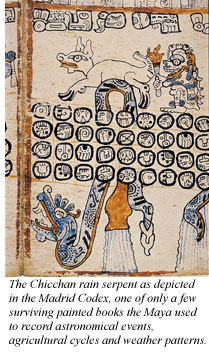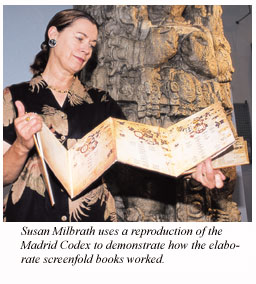Explore Magazine
Volume 6 Issue 2
 Mayan
Meltdown
Mayan
Meltdown
UF Geologists' Analysis Of
Ancient Lakebeds Leads To A Theory About The Decline Of Mayan Civilization
by Joseph Kays
David Hodell, Mark
Brenner and Jason Curtis watched intently as the 1.9-meter-long, clear
plastic tubes of sediment they had worked so hard to extract from
the bed of Mexico's Lake Chichancanab made their way through the GEOTEK
MultiSensor Core Logger.
Every half
centimeter, the state-of-the-art device fired a beam of gamma ray
radiation through the 2-inch-diameter cores, recording 2,600 years
of the lake's history to a computer.
Located in the heart of the Yucatan peninsula near the seat of power
for the northern half of the Mayan civilization that once dominated
Mexico and Central America, Lake Chichancanab's history should mirror
the environment in which the Mayan people of the region lived, the
researchers say.

And the data coming out of the core samples indicated significant
meteorological changes were occurring just as the Maya's life took
a dramatic turn for the worse.
The water in Lake Chichancanab, which means "little sea"
because of it saltiness, is nearly saturated with calcium sulfate,
or gypsum, so when lake water evaporates during dry periods, the gypsum
settles to the lake bottom, forever memorializing that drought in
the sediments.
 The
team, part of UF's new Land Use and Environmental Change Institute,
could easily see the strata of white gypsum segmenting the core like
icing between layers in a chocolate cake, but only the sensitivity
of the core logger could map those layers with the precision the three
University of Florida geologists needed to resolve their questions
about climate conditions around Lake Chichancanab during the last
three millennia.
The
team, part of UF's new Land Use and Environmental Change Institute,
could easily see the strata of white gypsum segmenting the core like
icing between layers in a chocolate cake, but only the sensitivity
of the core logger could map those layers with the precision the three
University of Florida geologists needed to resolve their questions
about climate conditions around Lake Chichancanab during the last
three millennia.
The May 2000 expedition to Chichancanab was the second the team made
to the region. Core samples collected during a 1993 expedition revealed
that the period between 800 and 1000 A.D. was the driest in 7,000
years in the region, leading them to publish a paper in the journal
Nature that suggested drought conditions contributed to the decline
of the Maya civilization.
 But
although the scientists were able to identify dry periods from the
1993 samples, the cores and the technology to study them lacked detail.
But
although the scientists were able to identify dry periods from the
1993 samples, the cores and the technology to study them lacked detail.
"From
our earlier research, we knew there was a drought, but we had no clues
as to its cause," says Hodell.
So, with
funding from the National Science Foundation Paleoclimate Program, they
returned to Lake Chichancanab and Punta Laguna in 2000 to get more samples.
These Chichancanab samples yielded considerably more seeds and other
organic matter that could be dated using radiocarbon techniques. The
new dates and improved technology - like the MultiSensor Core Logger
purchased with a $170,000 grant from the UF Opportunity Fund - allowed
them to develop a more detailed and accurately timed chronology of the
droughts.
 "With
these new cores and the high-resolution density records we generated,
we were able to detect cycles in the record," Hodell says.
"With
these new cores and the high-resolution density records we generated,
we were able to detect cycles in the record," Hodell says.
The dominant
cycle they found, of recurring droughts on the peninsula every 208 years,
"caught our attention," Hodell says, "because it is close
to a 206-year cycle that is thought to be due to variations in solar
intensity."
Burned
By The Sun God?
For 600 years, the Maya represented the height of pre-Columbian culture
in present-day Central America. During this "Classic Period,"
the Maya achieved great advances in science, architecture and social
organization. They mapped the heavens and developed extremely accurate
calendars; built elaborate temples, palaces and observatories; and established
complex societies.
Then, between 750 and 900 A.D., the Mayan civilization all but disappeared.
Construction of ceremonial buildings stopped and hieroglyphic writings
ceased.
Anthropologists, archaeologists and historians have debated the decline
of the Maya for a century, focusing primarily on social upheaval as
the root cause. Only recently have physical scientists like the UF researchers
entered the fray.
Archaeologists know the Maya were capable of precisely measuring the
movements of the sun, moon and planets, but Hodell said he is unaware
of any evidence the Maya knew about the bicentennial cycle that ultimately
may have played a role in their downfall.
"It's
ironic that a culture so obsessed with keeping track of celestial movements
may have met its demise because of a solar cycle," he says.
Hodell is the first to admit that he and his colleagues "aren't
really the experts on the human side. We provide a climate context for
the archaeologists. It's up to them to determine whether it has any
bearing on the civilization. Our data present a challenge to archaeologists
to look for evidence of human response to drought.
"The collapse of any civilization is a complex issue, and it would
be an oversimplification to attribute it to any single cause,"
says Hodell, "but we believe drought could be a root cause that
tipped the balance.
"Rapid growth of the Maya population during the Classic Period
may have strained the carrying capacity of the land, then the drought
comes and it triggers a cascade of events - decreasing agricultural
yields, malnutrition, increased competition for resources and warfare,
and general social upheaval," he continues.
The researchers say response to their theory has been mixed, particularly
among social scientists.
"Some people liked the premise," Hodell says, "while
others thought we were heretics."
"We didn't really change anyone's mind," Brenner adds. "People
who were inclined to focus on social phenomena stuck to their guns.
But it is difficult to deny the role of environment. It seems obvious
that culture is intimately connected to the environment."
Earth is currently in the middle of the 206-year solar cycle, Hodell
says, adding that even a severe drought today isn't likely to have the
same impact on a culture as in ancient times.
Brenner noted North Korea currently is suffering an extreme drought,
but the country has the benefit of international aid.
"Nobody stepped in to help the Maya out," he said, "and
as conditions worsened, it probably created a lot of stress among various
Maya cities competing for resources."
The research team is already analyzing core samples gathered from other
parts of Central America to confirm the existence of the 208-year drought
cycle. They hope this data can be used by climatologists and atmospheric
physicists to determine why a small increase in solar output had such
a large impact on the Central American climate.
Aaron
Hoover contributed to this article.
David
Hodell
Professor, Department of Geology
(352) 392-6137
dhodell@geology.ufl.edu
Mark
Brenner
Assistant Professor, Department of Geology
(352) 392-2231
brenner@ufl.edu
 Maya
Perspective
Maya
Perspective
By Susan Milbrath
My geologist husband,
Mark Brenner, and his colleagues, David Hodell and Jason Curtis, have
used geologic samples and astronomical cycles to develop a theory about
the role a drought caused by increased solar activity played in the
collapse of the Mayan civilization.
My work also involves the study of astronomy, but I take the perspective
of the Maya. Studying their art, calendar and folklore has helped me
reconstruct important elements of Maya astronomy. The discovery of the
"solar forcing" cycle now leads me to pose two anthropological
questions.
Did the Classic Maya record the dramatic changes in the weather seen
in the geological record?
The answer is both yes and no. What the Maya weren't writing about alludes
to changes in their culture more than what they were writing about.
For example, the Maya abruptly stopped erecting monuments with written
inscriptions in the ninth century, indicating some sort of cultural
collapse. Records of warfare, often timed to specific astronomical events,
came to an end at about the same time, as did chronicles of their kings
and queens.
After the Classic Maya collapse in the ninth century, written records
appear primarily in painted books called codices. Codices are made from
tree bark that has been flattened, covered with a lime plaster and folded
accordion-style. They are usually painted on both sides.
Only a very few of these screenfold books survive today, all dating
to the Postclassic period (A.D. 900-1541). They record almanacs focusing
on astronomy, agricultural cycles and weather patterns. The rain god
Chak is represented 134 times in the almanacs of the Dresden Codex,
while many other gods appear only once or twice.
The Dresden Codex traces a sequence of 584-day periods, documenting
Venus in relation to seasonal cycles of the sun and moon. Another almanac
in this codex shows the planet Mars as a "rain beast" connected
with the 780-day Mars cycle.
The Madrid Codex represents a 260-day planting cycle controlled by the
Chicchan "rain serpent," whose rattle tail represents the
constellation Pleiades. In the Madrid sequence, the disappearance of
the serpent's rattle coincides with the disappearance of the Pleiades
from view in May at the onset of the rainy season. The Yucatac Maya
still call the Pleiades "the rattlesnake's rattle" (tzab).
Detailed records of the Maya calendar and astronomical cycles allow
me to pose another question. Did the Maya have knowledge of longer astronomical
cycles related to climate change?
The answer seems to be no, although we do not yet understand all of
the Maya records.
The Maya were expert "naked-eye" astronomers, and they had
a continuous cultural tradition extending back to the time of Christ.
No almanacs have survived from this period, but some records of the
seventh and eighth centuries appear in a 13th-century codex.
The Maya had a complex series of calendars recording time cycles of
great length. One such cycle is the 52-year Calendar Round, synchronizing
their 260-day religious calendar with a 365-day calendar based on the
solar year. Two cycles of the Calendar Round (104 years) were used to
record a great Venus Round. This involved a Venus almanac of 5 Venus
cycles coordinated with the cycles of the sun and the moon over a period
of 8 years. This Venus almanac (5 x 584 days = 8 x 365) was repeated
13 times so that all three astronomical cycles would realign with the
260-day divination calendar after 65 Venus cycles. Doubling this cycle
we have a cycle of 208 years - which, oddly enough, fits rather neatly
with the solar forcing cycle.
Although this must be a coincidence, it seems likely that after more
than a millennium of observation, the Maya did develop some records
of long climate cycles. Watching for the rains to come in May each year
must go back to the dawn of Maya civilization.
Susan Milbrath
is Curator of Latin American Art and Archaeology at the Florida Museum
of Natural History and Affiliate Professor of Anthropology at the University
of Florida. She is the author of Star Gods of the Maya: Astronomy
in Art, Folklore, and Calendars.
 Mayan
Meltdown
Mayan
Meltdown
 The
team, part of UF's new Land Use and Environmental Change Institute,
could easily see the strata of white gypsum segmenting the core like
icing between layers in a chocolate cake, but only the sensitivity
of the core logger could map those layers with the precision the three
University of Florida geologists needed to resolve their questions
about climate conditions around Lake Chichancanab during the last
three millennia.
The
team, part of UF's new Land Use and Environmental Change Institute,
could easily see the strata of white gypsum segmenting the core like
icing between layers in a chocolate cake, but only the sensitivity
of the core logger could map those layers with the precision the three
University of Florida geologists needed to resolve their questions
about climate conditions around Lake Chichancanab during the last
three millennia. But
although the scientists were able to identify dry periods from the
1993 samples, the cores and the technology to study them lacked detail.
But
although the scientists were able to identify dry periods from the
1993 samples, the cores and the technology to study them lacked detail. "With
these new cores and the high-resolution density records we generated,
we were able to detect cycles in the record," Hodell says.
"With
these new cores and the high-resolution density records we generated,
we were able to detect cycles in the record," Hodell says. Maya
Perspective
Maya
Perspective